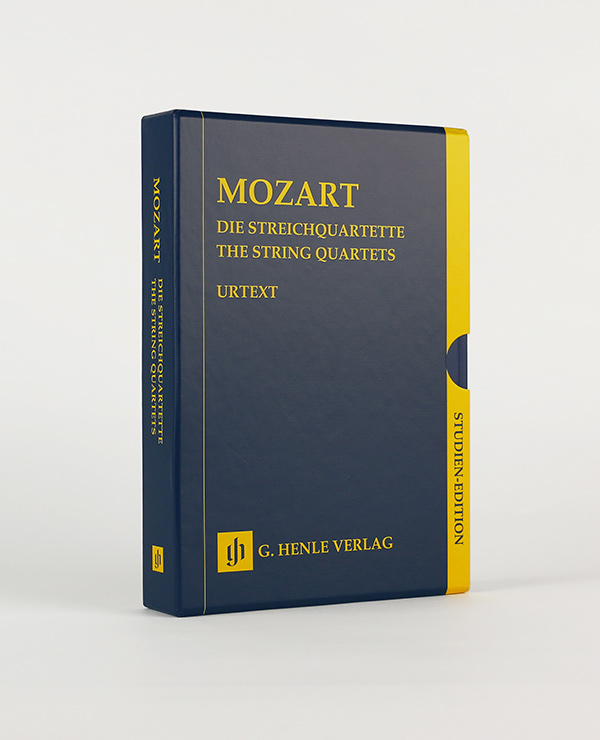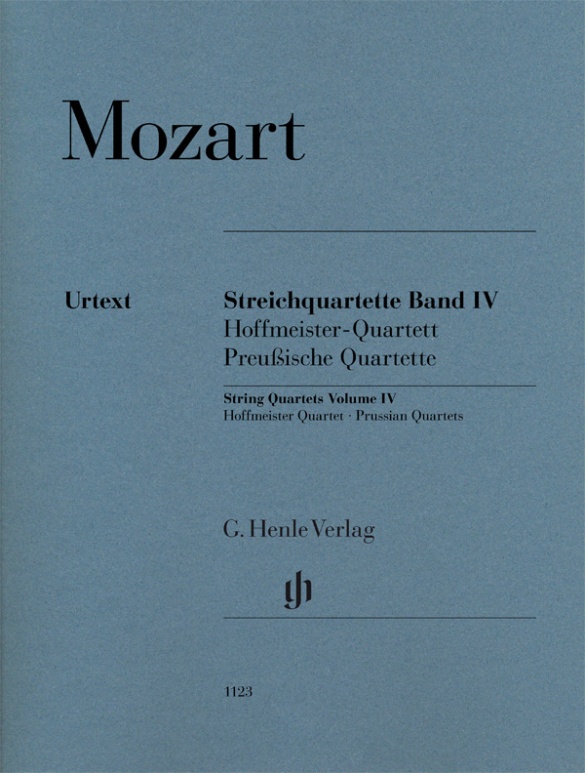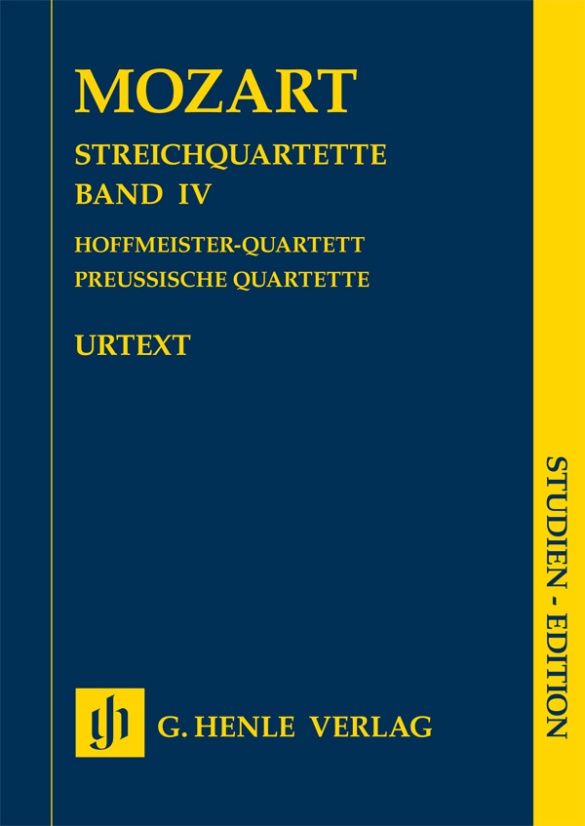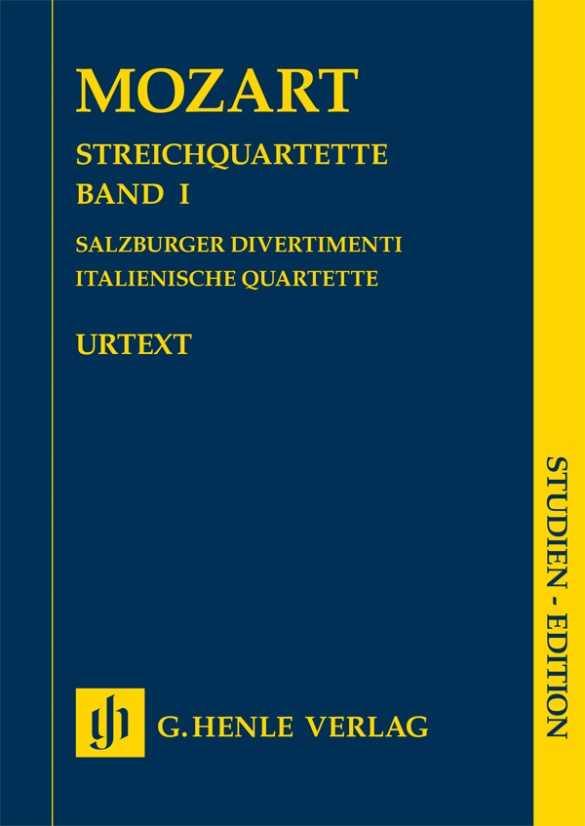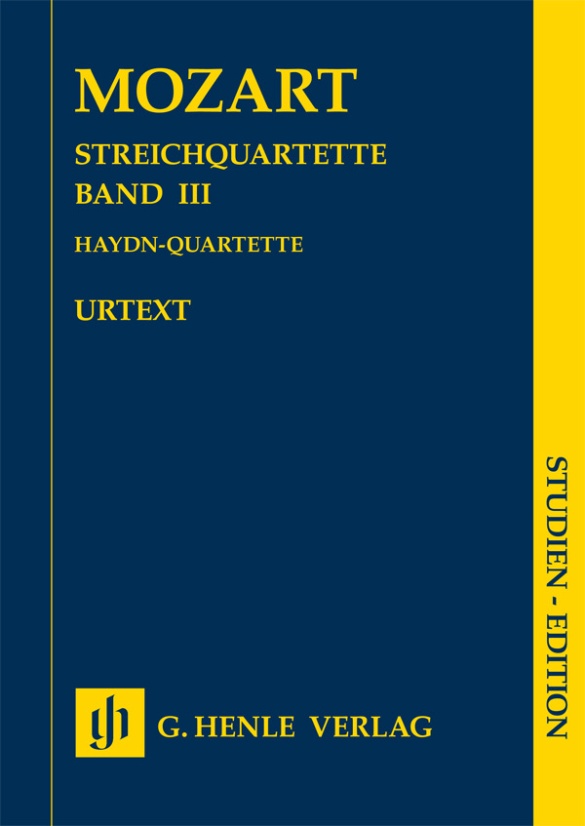

Wolfgang Amadeus Mozart
String Quartets, Volume III (Haydn Quartets)
Each of these four-movement works is a real jewel. Mozart worked hard on these six string quartets, and dedicated them to none other than the “inventor” of the genre himself: Joseph Haydn. They were first published in 1785, and have since then been reprinted innumerable times. Wolf-Dieter Seiffert, the editor of this new Henle Urtext edition, already penned the Critical Report for these Haydn Quartets in the New Mozart Edition, 25 years ago. He is now presenting this core repertoire in an edition of its own. This Urtext edition clarifies numerous inaccuracies in other editions, especially with regard to dynamics and articulation, and even corrects a few wrong notes that had gone unnoticed up to now. Special attention has here been paid to making the music as easy-to-read as possible, with ideally placed page turns.
Content/Details
About the Composer

Wolfgang Amadeus Mozart
Mozart is one of the few composers to have produced masterpieces in all genres. On the concert tours he undertook in his early years (London, Mannheim, Italy, Paris) he gained many varied musical impressions that he assimilated in his youth and which formed the prerequisite for his later consummate musical language.
| 1756 | Born in Salzburg on January 27, the son of musician and later court composer Leopold Mozart. His early regimented musical education from his father began in 1761, first compositions at age five. |
| 1763–66 | Extended concert tours through various German cities and to Paris, London, Amsterdam, Switzerland. He composes his first sonatas for violin and piano, K. 10–15, dedicated to Queen Charlotte, as well as the first symphonies from London, K. 16 and 19, which show the influence of the works of Johann Christian Bach and Karl Friedrich Abel (the three-movement Italian sinfonia form). |
| 1767 | Premiere in Salzburg of the sacred light opera “Die Schuldigkeit des ersten Gebotes,” K. 35 (written with Michael Haydn and Anton C. Adlgasser), and the intermezzo “Apollo et Hyacinthus,” K. 38. Journeys with his father and sister to Vienna. |
| 1768 | Probably the premiere in Vienna of his Singspiel “Bastien and Bastienne,” K. 50. Composition of his first masses. |
| 1769 | Performance in Salzburg of the dramma giocoso “La finta semplice,” K. 51. |
| 1769–71 | Two tours to Italy; he meets Farinelli, P. Nardini, and Padre Martini, among others, and, on the second trip, Hasse. Premieres in Milan of his opera seria “Mitridate, Re di Ponto” in 1770 and of the festa teatrale “Ascanio in Alba” in 1771. Composition of symphonies and his first string quartet (1770, K. 80). |
| 1771 | Composition of the oratorio “La Betulia liberate,” K. 118, in Salzburg/Italy. |
| 1772 | Premiere of the serenata drammatica “Il sogno di Scipione,” K. 126, for the accession of Salzburg Archbishop Hieronymus Count Colloredo. He receives an appointment as salaried concertmaster of the Salzburg Court Chapel (of which he had been an unpaid member since 1769). Third journey to Italy with his father, premiere in Milan of the dramma per musica “Lucio Silla,” with general success. The final trip to Italy spells the ends of his youthful phase of appropriation; he has tested out all important instrumental genres (symphony, sonata, string quartet) and all the main genres of opera (Singspiel, opera buffa, opera seria, festa teatrale). |
| from 1773 | Composition of string quartets (K. 168–173) under the influence of Haydn, and of symphonies, divertimenti, serenades. He increasingly devotes himself, contingent upon the duties of his post, to liturgical music; several masses are written. Begins to compose violin and piano concerti. |
| 1775 | Premiere in Munich of the dramma giocoso “La finta giardiniera” and the serenata “Il Rè pastore.” Piano sonatas, K. 279–284. |
| 1777 | He vacates his post temporarily to undertaken a promotional tour with his mother to Munich, Mannheim, and Paris. |
| 1778 | Composition of the “Paris” Symphony in D major (K. 297). In Paris he experiences the quarrel between the proponents of Gluck and those of Piccinni. Publication of violin sonatas. |
| 1779 | Resumes his duties in Salzburg, as court organist. Coronation Mass in C major. |
| 1781 | Premiere in Munich of his tragédie lyrique “Idomeneo,” in which French and Italian elements are synthesized. Journey to Vienna. After his falling out with the Archbishop of Salzburg, he gives up his post, moves to Vienna, and earns his living as a free composer through concertizing and giving music lessons. His last great period of creativity begins. |
| 1782 | He becomes acquainted with the works of Bach and Handel through Baron van Swieten; after this he arranges Bachian fugues and incorporates the “learned style” (fugues and counterpoint) into his works beside the “galant style” (e.g. in the String Quartet in G major, K. 387, in 1782; Piano Sonata in F major, K. 533, in 1786; the Jupiter Symphony, K. 551, in 1788; “Die Zauberflöte” (“The Magic Flute”), and the Requiem in D minor, K. 626, both in 1791). Premiere in Vienna of his Singspiel “Die Entführung aus dem Serail” (“The Abduction from the Seraglio”). Composition of the Haffner Symphony in D major, K. 385. |
| 1783 | Mass in C minor, K. 427; Linz Symphony in C major, K. 425. |
| 1784 | Hunt Quartet in B-flat major, K. 458. |
| 1785 | Premiere in Vienna of the oratorio “Davide penitente,” K. 469. “Dissonance” Quartet in C major, K. 465. |
| 1786 | Premiere of the comedy with music “Der Schauspieldirektor” (“The Impresario”), K. 486, which Salieri’s competing work “Prima la musica e poi le parole” (“First the Music and Then the Words”) bests. Premiere in Vienna of the opera buffa “Le nozze di Figaro” (“The Marriage of Figaro”), whose extended action-packed finales form a highpoint of opera buffa. Prague Symphony in D major, K. 504. |
| 1787 | Serenade in G major (“Eine kleine Nachtmusik”), K. 525. He is named imperial and royal chamber composer. Premiere in Prague of the dramma giocoso “Il dissoluto punito ossia Il Don Giovanni,” a synthesis of serious and comic opera. |
| 1788 | Composition of the large Symphonies in E-flat major, K. 543; G minor, K. 550; and C major (Jupiter Symphony), K. 551. Clarinet Quintet in A major, K. 581. |
| 1790 | Premiere in Vienna of the dramma giocoso “Così fan tutte ossia La scuola degli amanti.” |
| 1791 | Premiere in Prague of the opera seria “La clemenza di Tito” and in Vienna of the Singspiel “Die Zauberflöte.” Clarinet Concerto in A major, K. 622. The Requiem remains unfinished. Dies in Vienna on December 5. |
About the Authors
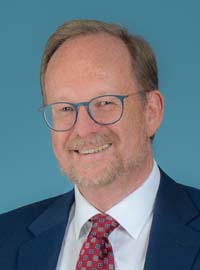
Wolf-Dieter Seiffert (Editor)
Dr. Wolf-Dieter Seiffert, born in 1959 in Frankfurt/M., read musicology, modern German literature, and philosophy at the Ludwig-Maximilians-Universität in Munich. On a scholarship from the “Studienstiftung des Deutschen Volkes”, he did his doctorate in 1990 with a thesis on “Mozarts frühe Streichquartette” (Rudolf Bockholdt). That same year, Seiffert started work at G. Henle Publishers as an editor. Parallel to his work at the publisher, he completed a diploma in business studies at the St. Gallen University, KMU-HSG, financed by the Günter Henle Foundation. Seiffert was managing director of G. Henle Verlag from 2000 to 2023.
Seiffert has edited numerous Urtext editions for G. Henle Publishers, predominantly on Mozart’s works.
Product Safety Informations (GPSR)

G. Henle Verlag
Here you can find the information about the manufacturer of the product.G. Henle Verlag e.K.
Forstenrieder Allee 122
81476 München
Germany
info@henle.de
www.henle.com
It goes without saying that the printing is beautiful and the paper of the highest quality. The typography is also exemplary, both in the detailed introductions and critical commentaries (in three languages!) and the music itself. Outstanding work at unbelievably reasonable prices!
Early Music Review, 2019So ergeben sich laut Seiffert doch im Detail ganz viele Verbesserungen für die quartettspielende Zunft. Wer wenn nicht er wäre für die Neuausgabe prädestiniert, der er schon 1989 ... kritische Berichte der NMA redigiert und verfasst hat!
European String Teachers Association, 2019Henle continues its fins tradition of meticulous editing with this handsome Urtext set of parts and study score, complete with an extensive Preface and Comments by Wolf-Dieter Seiffert.
Stringendo, 2020Mozart-expert Wolf-Dieter Seiffert levert voor Henle met regelmaat moderne, ruim opgezette kritische edities af, met speciale aandacht voor de speelbaarheid van de partijen en voor het corrigeren van foutjes en muzikale archaïsmen in voorgaande edities. ... De handige studiepartituren hebben alles weg van een definitieve versie.
de nieuwe muze, 2021Professionelle Quartette – und hoffentlich auch eifrige Liebhaber – kommen an dieser Gesamtedition in 4 Bänden nicht vorbei.
ESTA Nachrichten, 2022recommendations
autogenerated_cross_selling
Further editions of this title
Further editions of this title


